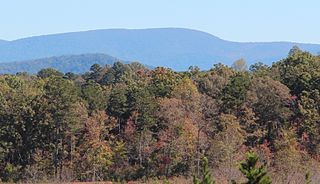Related Research Articles

The Appalachian National Scenic Trail, generally known as the Appalachian Trail or simply the A.T., is a marked hiking trail in the Eastern United States extending between Springer Mountain in Georgia and Mount Katahdin in Maine. The trail is about 2,200 miles (3,500 km) long, though the exact length changes over time as parts are rerouted or modified. The Appalachian Trail Conservancy describes the Appalachian Trail as the longest hiking-only trail in the world. More than 2 million people are said to take a hike on part of the trail at least once each year.

The 252-mile (406 km) Tuscarora Trail is a long distance trail in the Ridge and Valley Appalachians that passes through the US states of Virginia, West Virginia, Maryland, and Pennsylvania. In the south, the Tuscarora begins at a junction with the Appalachian Trail (AT) near Mathews Arm Campground, 0.4-mile (0.64 km) south of the AT's crossing of Skyline Drive at MP 21.1 in Shenandoah National Park in Virginia. In the north, it rejoins the Appalachian Trail at the top of Blue Mountain just west of the Susquehanna River and Harrisburg, Pennsylvania, creating a 435 mi (700.1 km) circuit known as the Tuscalachian Loop. The Tuscarora Trail was built as an alternative parallel route for the Appalachian Trail. It was built farther west, in a more wild corridor, because it was feared that development would force closure of the AT, before passage of the National Scenic Trails Act of 1968.

The Pacific Crest Trail (PCT), officially designated as the Pacific Crest National Scenic Trail, is a long-distance hiking and equestrian trail closely aligned with the highest portion of the Cascade and Sierra Nevada mountain ranges, which lie 100 to 150 miles east of the U.S. Pacific coast. The trail's southern terminus is just south of Campo, California by the U.S. border with Mexico, and its northern terminus is on the Canada–US border on the edge of Manning Park in British Columbia; it passes through the states of California, Oregon, and Washington.

The Delaware Water Gap is a water gap on the border of the U.S. states of New Jersey and Pennsylvania where the Delaware River cuts through a large ridge of the Appalachian Mountains. The gap constitutes the southern portion of the Delaware Water Gap National Recreation Area, which is used primarily for recreational purposes, such as rafting, canoeing, swimming, fishing, hiking, and rock climbing.

A Walk in the Woods: Rediscovering America on the Appalachian Trail is a 1997 travel book by the writer Bill Bryson, chronicling his attempt to thru-hike the Appalachian Trail during the spring and summer of 1996. For much of his journey, Bryson was accompanied by his friend Matt Angerer, who had previously appeared in Bryson's 1991 book Neither Here nor There: Travels in Europe.
Earl V. Shaffer, was an American outdoorsman and author known from 1948 as The Crazy One for attempting what became the first publicized claimed hiking trip in a single season over the entire length of the Appalachian Trail (AT). He also worked as a carpenter, a soldier specializing in radar and radio installation, and an antique dealer.

Springer Mountain is a mountain located in the Chattahoochee National Forest on the border of Fannin and Gilmer counties. Located in the Blue Ridge Mountains in northern Georgia, the mountain has an elevation of about 3,782 feet (1,153 m). Springer Mountain serves as the southern terminus for the Appalachian and Benton MacKaye trails.

Emma Rowena (Caldwell) Gatewood, known as Grandma Gatewood,, was an American ultra-light hiking pioneer. After a difficult life as a farm wife, mother of eleven children, and victim of domestic violence, she became famous as the first solo female thru-hiker of the 2,168-mile (3,489 km) Appalachian Trail (A.T.) in 1955 at the age of 67. She subsequently became the first person to hike the A.T. three times, after completing a second thru-hike two years later, followed by a section-hike in 1964. In the meantime, she hiked 2,000 miles (3,200 km) of the Oregon Trail in 1959. In her later years, she continued to travel and hike, and worked on a section of what would become the Buckeye Trail. The media coverage surrounding her feats was credited for generating interest in maintaining the A.T. and in hiking generally. Among many other honors, she was posthumously inducted into the Appalachian Trail Hall of Fame in 2012.

The Appalachian Trail Conservancy (ATC) is a nonprofit organization dedicated to the conservation of the Appalachian Trail, a route in the eastern United States that runs from Maine to Georgia. Founded in 1925, the ATC is responsible for the day-to-day management of the Appalachian Trail under a cooperative agreement executed with the National Park Service. It is the lead non-governmental organization in protecting the trail's 2,193 miles (3,529 km), 250,000 acre (1,000 km²) greenway and coordinates the work of some thirty-one Appalachian Trail maintaining clubs performing almost all of the on-the-ground maintenance work. The National Trails System Act, which established the National Trails System and brought the Appalachian Trail into the federal estate, enabled the trail to be managed as it had been since 1925, with central agency and NGO (ATC) coordination, but most trail work being performed by, in 2019, almost 6,000 volunteers.
Thru-hiking, or through-hiking, is the act of hiking an established end-to-end trail or long-distance trail with continuous footsteps in one direction.
The Appalachian National Scenic Trail spans fourteen U.S. states during its roughly 2,200 miles (3,500 km)-long journey: Georgia, North Carolina, Tennessee, Virginia, West Virginia, Maryland, Pennsylvania, New Jersey, New York, Connecticut, Massachusetts, Vermont, New Hampshire, and Maine. The southern end is at Springer Mountain, Georgia, and it follows the ridgeline of the Appalachian Mountains, crossing many of its highest peaks and running almost continuously through wilderness before reaching the northern end at Mount Katahdin, Maine.

Mount Oglethorpe is a mountain located in Pickens County, Georgia, United States. The southernmost peak in the Blue Ridge Mountains, the mountain has an elevation of 3,288 feet (1,002 m), making it the highest point in Pickens County, and the Atlanta Metropolitan Area.
The Great Eastern Trail is a north-south hiking route that runs roughly 1,600 miles (2,600 km) through the Appalachian Mountains west of the Appalachian Trail in the eastern United States. As of 2021, it is still under development. From south to north, it runs from Flagg Mountain in Alabama through Georgia, Tennessee, Kentucky, West Virginia, Virginia, Maryland, and Pennsylvania, ending in western New York state. A connection from Flagg Mountain south to the Florida-Georgia border is considered "Phase II Development".

The Eastern Continental Trail (ECT) is a network of hiking trails in the United States and Canada, reaching from Key West, Florida to Belle Isle, Newfoundland and Labrador.

The Triple Crown of Hiking informally refers to the three major U.S. long-distance hiking trails:

The Appalachian Trail Museum is located in Pine Grove Furnace State Park near Gardners, Pennsylvania, United States, and commemorates the builders, maintainers and hikers of the Appalachian Trail, including those in the Appalachian Trail Hall of Fame. Features include a 1959 trail shelter from Peters Mountain built by Earl Shaffer, the first A.T. thru-hiker, vintage hiking and trail building equipment, historic A.T. signs, A.T. displays on permanent loan from the Smithsonian Institution, a recreation of A.T. founder Benton MacKaye's Sky Parlor office and a display on the National Trails System Act of 1968. The Museum also has an extensive research library.
Gene Espy is recognized as the second person to thru-hike the Appalachian Trail, making the entire 2,025-mile journey alone in one outing, covering 14 states in just over 123 days.

North to Maine is a 2009 play by American playwright Brenton Lengel. It is the first play ever written about the Appalachian Trail and the thru-hikers who walk it. The play is sprawling and epic, with scenes taking place over the course of several months and many states, culminating with the ascent of Katahdin, the northern terminus of the Appalachian Trail.
Warren Doyle is a hiker and supporter of the Appalachian Trail. He holds the informal record for the hiking the entire Appalachian Trail the most times. From 1974 to 2017, as a labor of love, he organized and led 10 groups up the entire Appalachian Trail with a superlative completion rate. He is the founder of two organizations dedicated to the trail: the Appalachian Long Distance Hikers Association, and the Appalachian Trail Institute. He remains the Director of Appalachian Trail Institute.
Elizabeth Thomas is a thru-hiking champion and former women's unassisted speed record holder for the 2,181-mile (3,510 km) Appalachian Trail. She holds the hiking "Triple Crown," having completed the Appalachian Trail, Pacific Crest Trail, and the Continental Divide Trail. She is the pioneer of the Chinook Trail in Washington and the Wasatch Range in Utah. She is Vice President of the American Long Distance Hiking Association-West, an ambassador for the American Hiking Society, and an outdoors writer for Wirecutter, a New York Times publication. She is also Editor-in-Chief of Treeline Review, a hiking gear publication. As of 2018, she completed 20 long-distance wilderness hikes.
References
- ↑ Tate, J. R. (2013). Walkin' with the Ghost Whisperers: Lore and Legends of the Appalachian Trail. Stackpole Books. p. 356. ISBN 9780811745444.
- ↑ Dziengielewski, Chester (January 1952). "North to South". Appalachian Trailway News. 13/1: 5–6.
- ↑ Hammack, Laurence (July 6, 2011). "Did the man heralded as the first to walk the entire Appalachian Trail take a shortcut into history?". Roanoke Times. Retrieved 18 July 2018.
Clarification
- 1 2 Adkins, Leonard M. (2015). Along the Appalachian Trail: West Virginia, Maryland, and Pennsylvania. Arcadia Publishing. p. 120. ISBN 9781467123266 . Retrieved 18 July 2018.